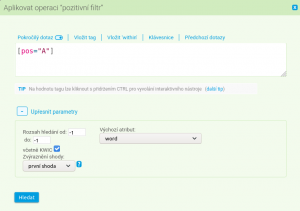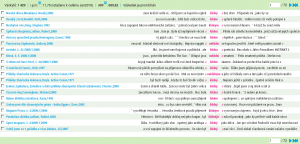This is an old revision of the document!
Menu: Filter
Filtering of the query results (concordance) can be used to specify the initial query by additional condition. In general, it is possible to replace any type of filter by a more complicated CQL query, nonetheless when doing some types of searches it is recommended to begin with a more general query and subsequently specify the results you wish to obtain. The advantage of this method is the possibility of continuous checking for what kind of results appear in the concordance.
In interface KonText there are two types of filter to choose from:
- P-filter (positive filter)
- N-filter (negative filter)
While the positive filter is used to select a subset of concordances from the initial list, the negative filer allows to remove some of the irrevelant concordances from the list. As for the p-filter, the user specifies the condition which has to be met in order for a line to stay in the concordance list. According to the user's specification, n-filter identifies those concordances, which are to be removed from the result (the ones that satisfy the condition are eliminated).
Within the form for filtering it is necessary to initially specify the type of filter (positive/negative). Additional settings specify the condition (which is basically additional query applied to the results of the original search): search span within which will the filtered feature be searched, type of query which will be used and entry of the filtered query.
The option Selected token (with the values first, last) is useful only for positive filtering. It specifies which of the context words should be marked as co-occurrence in KWIC in case there are more than one such words occuring in its proximity. For example, when searching for lemma klidný you find the following sentence:
Stal se nervózním a neklidným a jeho oči těkaly.
If you wish to filter out only those concordances in which the conjunction a occurs in immediate proximity of lemma klidný, in that case you have two options: either you mark the previous conjuction as a co-occurrence, or the one that follows KWIC. If you select first selected token in the settings of filter, the leftmost token will be marked in the searched context. If you select last, the one that is farthest to the right will be marked.
The assessment of the filter automatically redirects the user to the page with the updated concordance. In the case of the negative filter the specified examples are erased from the concordance (the number of concoradne rows will also be lowered). In the case of the positive filte the resultant concordance contains only those rows that satisfy the condition, the overall frequency is also correspondingly lowered, the context co-occurrences (if there are any) are marked red. Vyhodnocení filtru automaticky přesměruje uživatele na stránku s aktualizovanou konkordancí. V případě negativního filtru jsou specifikované případy z konkordance vymazány (sníží se také počet konkordančních řádků). V případě filtru pozitivního jsou ve výsledné konkordanci pouze vyhovující řádky, celková frekvence je rovněž adekvátně snížena, kookurence v kontextu (jsou-li nějaké) jsou vyznačeny červenou barvou.









